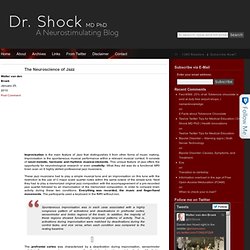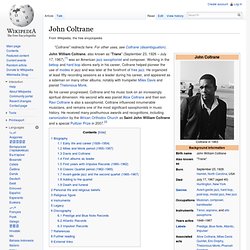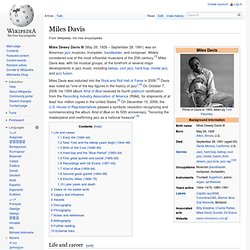

Charlie Parker Jazz Festival: The Wallace Roney Orchestra / Lionel Loueke / Melissa Aldana / Kris Bowers & guest Chris Turner at Marcus Garvey Park, NYC on SUMMERSTAGE. Boogie Everywhere I Go - John Lee Hooker. Spann's Blues - Otis Spann. John Lee Hooker. John Lee Hooker and Bonnie Raitt play "I'm In The Mood" 10 Ways to Share Music on Twitter. Twitter is fast becoming one of the most important ways to share information quickly, easily, and instantly over the web.

Users and developers have found a lot of innovative ways to pack a ton of utility into just 140 characters, including sharing images, sharing video, and sharing documents. What about music? Turns out, there are plenty of ways to share tunes on Twitter as well. Below are ten of the best ways to tweet about what you're listening to. If you know of any other ways to share music on Twitter that we should be aware of, please let us know in the comments. 1. Tinysong is a very basic URL shortener for music powered by P2P music sharing service Grooveshark. 2. If you want a more complete integration between Grooveshark and Twitter, you'll want to check out Twisten.fm. 3. Song.ly is a Twitter music sharing service powered by the Russian media search engine Tagoo. 4. 5. 6. 7. 8. 9. imeem 10.
Fretwork - Pavan Lachrimae Antiquae (John Dowland) Big Mama Thornton - Hound Dog - Down Home Shakedown - Live 1965. Charlie Parker Plays with Dizzy Gillespie in Only Video Capturing the “Bird” in True Live Performance. Here’s a historic TV broadcast of the founding fathers of bebop, Charlie Parker and Dizzy Gillespie, playing together in 1952.

It’s one of only two known sound films of Parker playing–and the only one of him playing live, rather than synching to a prerecorded track. The performance is from a February 24, 1952 broadcast on the pioneering DuMont Television Network. The full segment begins with a brief ceremony in which Parker and Gillespie receive awards from Down Beat magazine, but the clip above cuts straight to the music: a performance of the bebop standard “Hot House,” composed by Tad Dameron around the harmonic structure of Cole Porter’s “What Is This Thing Called Love?”
Mingus Big Band- Moanin' Mambo. The Neuroscience of Jazz. Improvisation is the main feature of Jazz that distinguishes it from other forms of music making.

Improvisation is the spontaneous musical performance within a relevant musical context. It consists of novel melodic, harmonic and rhythmic musical elements. This unique feature of jazz offers the opportunity for neurobiological research or even creativity. What they did was do a functional MRI brain scan on 6 highly skilled professional jazz musicians. These jazz musicians had to play a simple musical tune and an improvisation on this tune with the restriction to the use of C major scale quarter notes within the same octave of the simple tune. Spontaneous improvisation was in each case associated with a highly congruous pattern of activations and deactivations in prefrontal cortex, sensorimotor and limbic regions of the brain. The changes in the prefrontal cortex consisted of a deactivation in the lateral parts and activation in the medial parts of the prefrontal cortex.
Like this: Bill Evans. William John Evans, known as Bill Evans (pronunciation: /ˈɛvəns/, August 16, 1929 – September 15, 1980), was an American jazz pianist and composer who mostly worked in a trio setting.

The Bill Evans Trio - How Deep Is The Ocean (1965) Bill Evans Trio - Someday My Prince will Come. John Coltrane. John William Coltrane, also known as "Trane" (September 23, 1926 – July 17, 1967),[1] was an American jazz saxophonist and composer.

Working in the bebop and hard bop idioms early in his career, Coltrane helped pioneer the use of modes in jazz and was later at the forefront of free jazz. He organized at least fifty recording sessions as a leader during his career, and appeared as a sideman on many other albums, notably with trumpeter Miles Davis and pianist Thelonious Monk. As his career progressed, Coltrane and his music took on an increasingly spiritual dimension. His second wife was pianist Alice Coltrane and their son Ravi Coltrane is also a saxophonist. Coltrane influenced innumerable musicians, and remains one of the most significant saxophonists in music history.
Biography[edit] Coltrane's first recordings were made when he was a sailor. Stan Getz and John Coltrane. So What - Jonh Coltrane and Miles Davis. Miles Davis. Miles Dewey Davis III (May 26, 1926 – September 28, 1991) was an American jazz musician, trumpeter, bandleader, and composer.

Widely considered one of the most influential musicians of the 20th century,[3] Miles Davis was, with his musical groups, at the forefront of several major developments in jazz music, including bebop, cool jazz, hard bop, modal jazz, and jazz fusion. Miles Davis was inducted into the Rock and Roll Hall of Fame in 2006.[4] Davis was noted as "one of the key figures in the history of jazz".[4] On October 7, 2008, his 1959 album Kind of Blue received its fourth platinum certification from the Recording Industry Association of America (RIAA), for shipments of at least four million copies in the United States.[5] On December 15, 2009, the U.S. Miles Davis & John Coltrane - Kind of blue.
Miles Davis - Kind of Blue 50th Anniversary.